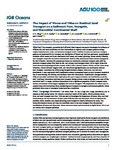The Impact of Waves and Tides on Residual Sand Transport on a Sediment‐Poor, Energetic, and Macrotidal Continental Shelf
| dc.contributor.author | King, EV | |
| dc.contributor.author | Conley, Daniel | |
| dc.contributor.author | Masselink, Gerd | |
| dc.contributor.author | Leonardi, N | |
| dc.contributor.author | McCarroll, Jak | |
| dc.contributor.author | Scott, Tim | |
| dc.date.accessioned | 2019-07-30T17:27:33Z | |
| dc.date.available | 2019-07-30T17:27:33Z | |
| dc.date.issued | 2019-06-27 | |
| dc.identifier.issn | 2169-9275 | |
| dc.identifier.issn | 2169-9291 | |
| dc.identifier.other | 0 | |
| dc.identifier.uri | http://hdl.handle.net/10026.1/14719 | |
| dc.description.abstract |
<jats:title>Abstract</jats:title><jats:p>The energetic, macrotidal shelf off South West England was used to investigate the influence of different tide and wave conditions and their interactions on regional sand transport patterns using a coupled hydrodynamic, wave, and sediment transport model. Residual currents and sediment transport patterns are important for the transport and distribution of littoral and shelf‐sea sediments, morphological evolution of the coastal and inner continental shelf zones, and coastal planning. Waves heavily influence sand transport across this macrotidal environment. Median (50% exceedance) waves enhance transport in the tidal direction. Extreme (1% exceedance) waves can reverse the dominant transport path, shift the dominant transport phase from flood to ebb, and activate sand transport below 120‐m depth. Wave‐tide interactions (encompassing radiation stresses, Stoke's drift, enhanced bottom‐friction and bed shear stress, refraction, current‐induced Doppler shift, and wave blocking) significantly and nonlinearly enhance sand transport, determined by differencing transport between coupled, wave‐only, and tide‐only simulations. A new continental shelf classification scheme is presented based on sand transport magnitude due to wave‐forcing, tide‐forcing, and nonlinear wave‐tide interactions. Classification changes between different wave/tide conditions have implications for sand transport direction and distribution across the shelf. Nonlinear interactions dominate sand transport during extreme waves at springs across most of this macrotidal shelf. At neaps, nonlinear interactions drive a significant proportion of sand transport under median and extreme waves despite negligible tide‐induced transport. This emphasizes the critical need to consider wave‐tide interactions when considering sand transport in energetic environments globally, where previously tides alone or uncoupled waves have been considered.</jats:p> | |
| dc.format.extent | 4974-5002 | |
| dc.language | en | |
| dc.language.iso | en | |
| dc.publisher | American Geophysical Union | |
| dc.relation.uri | http://hdl.handle.net/10026.1/14608 | |
| dc.subject | sand transport | |
| dc.subject | wave-current interaction | |
| dc.subject | continental shelf | |
| dc.subject | sediment transport | |
| dc.subject | residual current | |
| dc.subject | classification scheme | |
| dc.title | The Impact of Waves and Tides on Residual Sand Transport on a Sediment‐Poor, Energetic, and Macrotidal Continental Shelf | |
| dc.type | journal-article | |
| dc.type | Journal Article | |
| plymouth.author-url | https://www.webofscience.com/api/gateway?GWVersion=2&SrcApp=PARTNER_APP&SrcAuth=LinksAMR&KeyUT=WOS:000482059700036&DestLinkType=FullRecord&DestApp=ALL_WOS&UsrCustomerID=11bb513d99f797142bcfeffcc58ea008 | |
| plymouth.issue | 7 | |
| plymouth.volume | 124 | |
| plymouth.publication-status | Published | |
| plymouth.journal | Journal of Geophysical Research: Oceans | |
| dc.identifier.doi | 10.1029/2018jc014861 | |
| plymouth.organisational-group | /Plymouth | |
| plymouth.organisational-group | /Plymouth/Faculty of Science and Engineering | |
| plymouth.organisational-group | /Plymouth/Faculty of Science and Engineering/School of Biological and Marine Sciences | |
| plymouth.organisational-group | /Plymouth/PRIMaRE Publications | |
| plymouth.organisational-group | /Plymouth/REF 2021 Researchers by UoA | |
| plymouth.organisational-group | /Plymouth/REF 2021 Researchers by UoA/UoA07 Earth Systems and Environmental Sciences | |
| plymouth.organisational-group | /Plymouth/Research Groups | |
| plymouth.organisational-group | /Plymouth/Research Groups/Marine Institute | |
| plymouth.organisational-group | /Plymouth/Users by role | |
| plymouth.organisational-group | /Plymouth/Users by role/Academics | |
| plymouth.organisational-group | /Plymouth/Users by role/Researchers in ResearchFish submission | |
| dcterms.dateAccepted | 2019-06-20 | |
| dc.rights.embargodate | 2019-11-27 | |
| dc.identifier.eissn | 2169-9291 | |
| dc.rights.embargoperiod | Not known | |
| rioxxterms.versionofrecord | 10.1029/2018jc014861 | |
| rioxxterms.licenseref.uri | http://www.rioxx.net/licenses/all-rights-reserved | |
| rioxxterms.licenseref.startdate | 2019-06-27 | |
| rioxxterms.type | Journal Article/Review | |
| plymouth.funder | Physical and biological dynamic coastal processes and their role in coastal recovery (BLUE-coast)::NERC |


